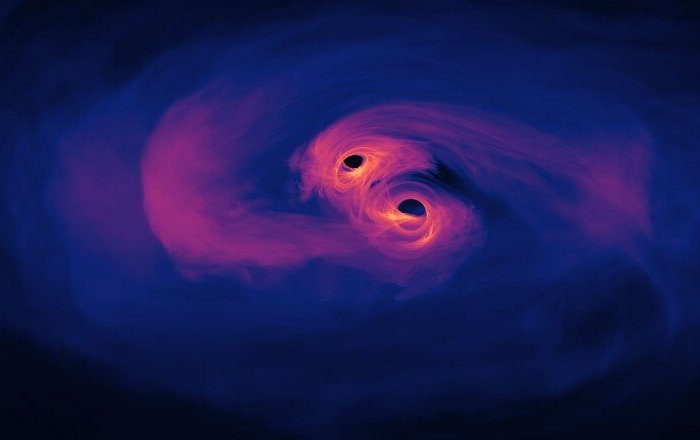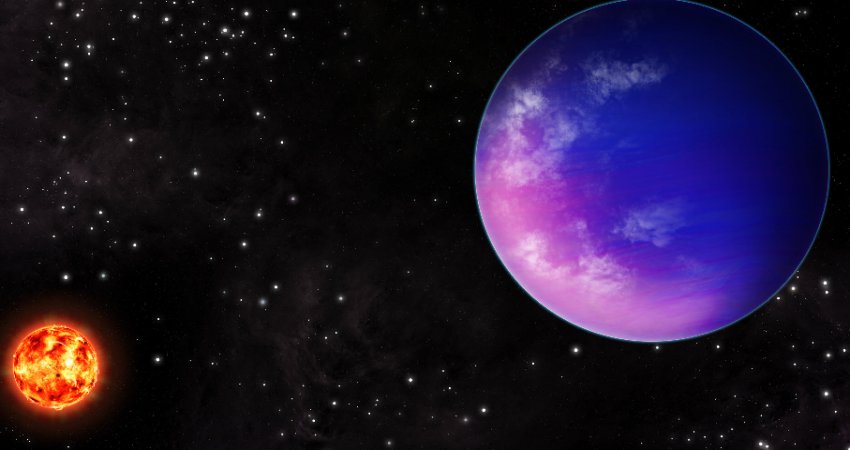New Study Further Narrows The Search For Elusive Pairs Of Monster Black Holes
Eddie Gonzales Jr. – MessageToEagle.com – Although astrophysicists have never sensed supermassive black hole binary systems, a galaxy-sized detector composed of dead stars is hot on their trail.
In a new Northwestern University-led study, astrophysicists crunched 12.5 years of data from 45 dead stars (called pulsars) to set the best limits yet on the gravitational wave signatures emitted from pairs of monster black holes.
 Illustration of a supermassive black hole binary. Credit: NASA’s Goddard Space Flight Center/Scott Noble
Illustration of a supermassive black hole binary. Credit: NASA’s Goddard Space Flight Center/Scott Noble
Knowing these limits will help astrophysicists constrain the number of binaries existing in the nearby universe, confirm or deny existing binary candidates and, someday, detect gravitational waves from these complex pairs.
In another breakthrough, the study also found that when searching for pairs of supermassive black holes, researchers need to account for the steady hum of background noise made by the symphony of gravitational waves from all the supermassive black hole binaries in the universe.
The study, titled “The NANOGrav 12.5-year data set: Bayesian limits on gravitational waves from individual supermassive black hole binaries,” was accepted by The Astrophysical Journal Letters and will be published this summer. It is currently published on the arXiv preprint server.
“We genuinely think that detection of a supermassive black hole binary through gravitational waves is right around the corner,” said Northwestern’s Caitlin Witt, who led the study.
“That would be an important discovery for many scientific fields. It would enable us to perform further experiments like testing gravity to explore whether supermassive black hole binaries evolve the way we think they do, and it will teach us how to look for them in future surveys. We also will be able to look back through cosmic time and trace the history of the universe in which we live.”
Witt is the inaugural CIERA-Adler Postdoctoral Fellow at Northwestern’s Center for Interdisciplinary Exploration and Research in Astrophysics (CIERA) and the Adler Planetarium.
Too big to detect
Located in the center of most galaxies, supermassive black holes can be several billion times the mass of our sun. Compared to typical stellar-mass black holes, which are 10 to 100 times more massive than our sun, supermassive black holes are unfathomably gigantic.
When two galaxies—each with a central supermassive black hole—merge together, it can create a binary system of these monstrous black holes.
“Someday, our galaxy will collide with the Andromeda galaxy,” Witt said. “Millions of years after that, the black holes eventually find each other to form a little buddy system. Detecting gravitational waves from systems like these will help us understand how galaxies interact and how the universe evolves.”
In 2016, an international team co-led by Northwestern professor Vicky Kalogera used the Laser Interferometer Gravitational-Wave Observatory (LIGO) to first detect gravitational waves from the merger of two stellar-mass black holes, which resulted in obvious, short-lived ripples in space-time. But supermassive black hole binaries are too big and much too far apart for Earth-based equipment like LIGO to detect.
These monster pairs create waves so long that it could take years or even decades for their gravitational waves to fully wash over Earth. Even when NASA and the European Space Agency launch LISA (a space-based gravitational-wave detector for which Northwestern professor Shane Larson is a co-principal investigator) in the early 2030s, it still will not be able to detect such enormous waves.
“LIGO can only detect wavelengths that fit within its arms,” Witt said. “We have to look for much lower wave frequencies. We are sensitive to supermassive black hole pairs that can take a month or even up to 15 years to orbit each other. So, we’re looking for a steady signal that could blend into the background.”
Pulsars tick like a clock
To overcome this obstacle, an international collaboration of researchers established the North American Nanohertz Observatory for Gravitational Waves (NANOGrav), which hunts for gravitational waves using pulsars, a type of rapidly rotating neutron star born in the supernova explosion of a massive star at the end of its life. Just like a lighthouse, a pulsar emits a light beam that flashes by as it rotates.
“Because pulsars spin so stably, we see little flashes of light that tick like a clock,” Witt said. “We watch that light with ground-based radio telescopes. If the clock ticks arrive either a little bit early or a little bit late, this is a sign that it could have been affected by a gravitational wave.”
NANOGrav tracks 75 pulsars—45 of which were used in this study—located all across the night sky. Their beams of light take mere milliseconds to flicker past Earth. So, in this case, “a little bit early or a little bit late” could mean a fraction of a nanosecond. Therefore, NANOGrav’s techniques must be incredibly sensitive to capture these nearly imperceptible changes.
By looking across the entire sky, Witt and the NANOGrav team search for specific patterns from all pulsars together. According to theory, supermassive black hole binaries should emit gravitational waves that literally stretch and squeeze (or strain) space-time on their way to Earth. Warped space-time will affect pulsars’ light beams in such a way that indicates an elusive pair of monster black holes.
‘Red noise can trick us’
But, of course, pulsars also generate their own noise, which can muddy the signals.
“Pulsars do have some intrinsic noise called ‘red noise,'” Witt said. “Their insides might slowly wobble a little bit, which you wouldn’t be able to see unless you were looking as closely as we are. That red noise looks similar to the broad gravitational wave noise that we’re looking for. We have to tease that apart.”
Last year, the NANOGrav team published a study finding a red noise process in all pulsars that shares the same common characteristics. Without more evidence, however, NANOGrav cannot attribute this to gravitational waves. In the new study, Witt and her team found that this red noise still must be carefully considered in order to definitively detect gravitational waves from individual supermassive black hole binaries.
“When a gravitational wave becomes detectable, it looks very similar to red noise at first glance,” Witt said. “The red noise can trick us. Our new study tells us that we must look closely to avoid getting confused. That will be important to watch for when we do finally detect gravitational waves.”
Although NANOGrav has yet to detect supermassive black hole binaries with gravitational waves, Witt’s new paper brings the field closer than ever. By leveraging the 12.5-year dataset, the researchers created new models to accurately account for uncertainties in the pulsar data and implement new techniques to account for the red noise.
Confirming candidates
These new models provide the tightest limits yet on the strength of gravitational waves emitted from supermassive black hole pairs. Previously, other researchers discovered potential supermassive black hole binaries with light-based telescopes. NANOGrav could eventually confirm that these potential candidates are, indeed, supermassive black hole binaries.
“With our new methods, we might be able to confirm this sooner,” Witt said. “Or, if we continue gathering and analyzing data, then we might be able to rule it out as a candidate. It might just be something else weird going on in the galaxy.”
Written by Eddie Gonzales Jr. – MessageToEagle.com Staff










